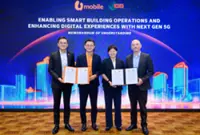The government is aiming to achieve 80% coverage in populated areas by the end of 2023. — AZHAR MAHFOF/The Star
PETALING JAYA: Despite efforts to increase 5G network coverage in populated areas, the adoption rate for 5G currently stands at only 1.2 million subscribers.
According to the Malaysian Communications and Multimedia Commission (MCMC) chief operating officer Datuk Mohd Ali Hanafiah Mohd Yunus, the “current adoption rate is unfortunately still low”.





